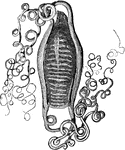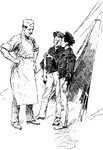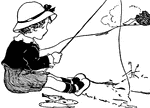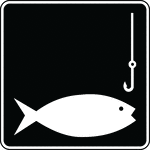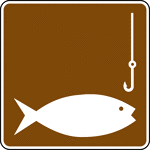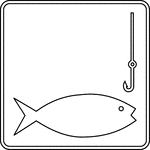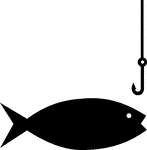
Conger Eel
"It varies in length from three to ten feet, and in weight from five to one hundred and thirty pounds.…

Electric Eel
The Electric Eel (Electrophorus electricus) is a fish in the Gymnotidae family of naked-back knifefishes.
Sharp-Nosed Eel
"It is from one to four feet long, and weighs from one to twenty-five pounds. This species feed on frogs…

Sharp-Nosed Eel
The sharp-nosed eel (Anguilla acutirostris) is a is also known as the European eel (Anguilla anguilla).

Snipe Eel
"An eel-like fish, Nemichthys scolopaceus; any member of the Nemichthyidae. The snipe eel attains a…
Snubnosed Eel
The Snubnosed Eel (Simenchelys parasitica) is a fish in the Synaphobranchidae family of cutthroat eels.
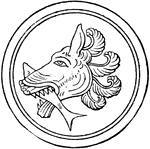
Episemon
Episema were used in Greece as a symbol for a country, region, or used on a shield or badge. This episemon…

European Bullhead
The European bullhead, Cottus gobio, is a fish of the Cottidae family that is widely distributed in…

Jesus Feeds More Than Four Thousand People with Seven Loaves and Two Fishes
"and he took the seven loaves and the fishes; and he gave thanks and brake, and gave to the disciples,…
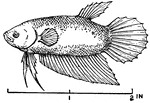
Fighting Fish
Betta pugnax, also known as the Fighting Fish (on account of its pugnacious habits), is a bony fish…
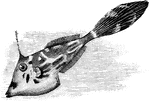
Orange Filefish
The Orange Filefish (Aluterus schoepfii) is a species of fish in the Monacanthidae family of filefish,…

Fish
Outline of a fish, showing the "paired" and "median" fins. (p) one of the pectoral fins; (v) one of…
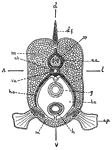
Fish
This is a diagram of the cross section of a fish, showing the bilateral symmetry of the parts: dv, dorsoventral…

Fish Circulation
"Diagram of the principal vessels in the circulation of a fish, ventral view. a, aorta; au., auricle;…

Flying Fish
"The Flying fish, with wings expanded and elevated in the act of flight. This anomalous and interesting…
Garpikes Fish
The gars, or garpikes, are members of the Lepisosteiformes (or Semionotiformes), an ancient order of…
Garpikes Fish
The spotted Gar (Lepisosteus oculatus) is a primitive freshwater fish of the family Lepisosteidae, native…
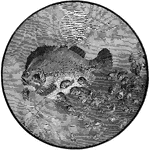
Lump Fish
An illustration of the Cyclopterus lumpus or "lump-fish" found commonly on the coast of Maine. These…

Remora Fish
A genus of fished included in the Goby family, and of which the common remora or sucking fish, is the…
Scabbard Fish
Lepidopus caudatus. "1. A fish of the family Lepidopodidae, Lepidopus caudatus,of the Mediterranean…

The Muscles of a Fish
In fish the chief masses of the muscular system are disposed on each side of the trunk in a series of…

Fisherman
An African American adult male standing in tall grasses holding a fish on one hand and his hat in another.
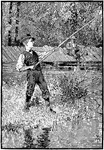
Boy Fishing with Cane Pole
An illustration of a young boy standing on the shore of a lake fishing with a cane pole.
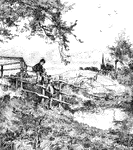
Young Boys Fishing
An illustration of two young boys; one is fishing, the other is sitting on a fence.

Flounder
Flounder keep near the bottom, swimming on one side, and the two eyes are both on the side that is uppermost.

Flounder
"Is found at the mouths of nearly all European rivers, and is especially abundant where the bottom is…

Flounder
A common fish known for its flat appearance and both eyes being on the upper, darker side of its body.

American Fourspot Flounder
The American Fourspot Flounder (Hippoglossina oblonga) is a fish in the Paralichthyidae family of large-tooth…

Lefteye Flounder (Scaldfish)
The scaldfish (Arnoglossus laterna) is a species of lefteye flounder of the Bothidae family.

Flying Fish
The Flying Fish is enabled to fly by having fins which approach in extent the wings of a bird, (Hooker,…

Flying Fish
"Is twelve to fourteen inches long, and has the ventral fins placed anterior to the middle part of the…

Great Forked-Beard
"One to two feet long, with a long barbule hanging from each chin." — Goodrich, 1859
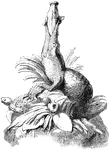
Water Fountain
This water fountain is made out of cast iron. It has a design of a crocodile holding a fish in his mouth,…
Four Eyes
"There are several species of the genus, Anableps, the principal one being Four Eyes, inhabiting the…
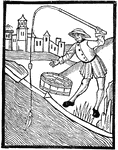
Fyshynge with an Angle
A print from the engraving, ""Fyshynge with an Angle" from 'The Book of St. Albans' printed by Wynkyn…
Gar
The gar fish has a cylindrical body covered by rhomboidal bony scales that are coated with enamel, making…

Gar
"Two feet long, with the under jaw greatly protruded; it swims near the surface; bites at a hook; makes…
Shortnose Gar
The Shortnose Gar (Lepisosteus platostomus) is a fish in the Lepisosteidae family of garpikes.
Gill Arch and Plates
Section through the gill arch and plates of a bony fish. Labels: b, gill plates with capillaries; c,…

